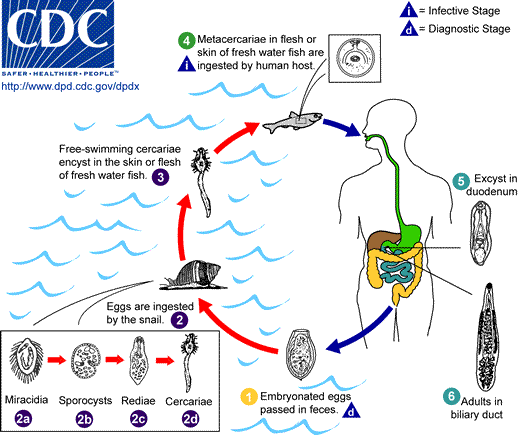Opisthorchiasis pathophysiology
|
Opisthorchiasis Microchapters |
|
Diagnosis |
|---|
|
Treatment |
|
Case Studies |
|
Opisthorchiasis pathophysiology On the Web |
|
American Roentgen Ray Society Images of Opisthorchiasis pathophysiology |
|
Risk calculators and risk factors for Opisthorchiasis pathophysiology |
Editor-In-Chief: C. Michael Gibson, M.S., M.D. [1]
Pathophysiology
Etiologic agent:
Trematodes (flukes) Opisthorchis viverrini (Southeast Asian liver fluke) and O. felineus (cat liver fluke).
Life cycle:

The adult flukes deposit fully developed eggs that are passed in the feces 1.
After ingestion by a suitable snail (first intermediate host) 2, the eggs release miracidia 2a, which undergo in the snail several developmental stages (sporocysts 2b, rediae 2c, cercariae 2d).
Cercariae are released from the snail 3 and penetrate freshwater fish (second intermediate host), encysting as metacercariae in the muscles or under the scales 4.
The mammalian definitive host (cats, dogs, and various fish-eating mammals including humans) become infected by ingesting undercooked fish containing metacercariae.
After ingestion, the metacercariae excyst in the duodenum 5 and ascend through the ampulla of Vater into the biliary ducts, where they attach and develop into adults, which lay eggs after 3 to 4 weeks 6.
The adult flukes (O. viverrini: 5 mm to 10 mm by 1 mm to 2 mm; O. felineus: 7 mm to 12 mm by 2 mm to 3 mm) reside in the biliary and pancreatic ducts of the mammalian host, where they attach to the mucosa.
External Links
http://www.dpd.cdc.gov/dpdx/HTML/Opisthorchiasis.htm